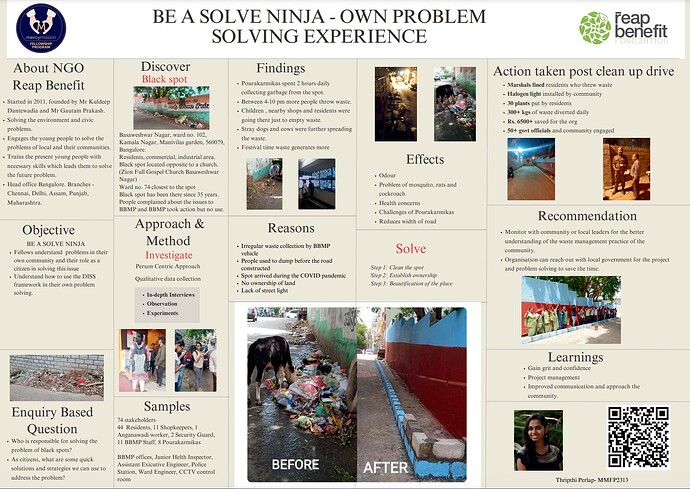Thripthi Perlap embarks on a mission to solve a longstanding civic issue in the community of Basaweshwar Nagar, Bangalore—an unmanaged black spot of waste that had existed for over 35 years. She had to work in a new area, a city with different culture, while she grew up in a village in Mangalore. The black spot was the source of numerous challenges including mosquito infestations, health hazards, and a burden on the local Pourakarmikas (sanitation workers). Community members, despite repeated complaints to the BBMP (Bruhat Bengaluru Mahanagara Palike), saw no sustainable change.
Thripthi, a Solve Ninja, recognized the issue as both a personal challenge and eventually an opportunity to develop civic skills, build community collaboration, and contribute to systemic change.
Steps in Project Implementation [Scroll down for more details]
1. Problem Discovery and Enquiry
Thripthi starts by investigating the root causes of the black spot’s persistence. Through in-depth interviews, observations, and experiments, she engages with 74 stakeholders, including residents, shopkeepers, and BBMP staff. This human-centered approach uncovers key issues: irregular waste collection, lack of land ownership, absence of streetlights, and behavior patterns leading people to dump waste at this location. She went through 6 levels of authority to work on one problem on that street - Junior Health Inspector , Police, Assistant Executive Engineer, Supervisor, Ward Engineer, and Control Room [ Link to zonal contact details of solid waste management officers in BBMP ]
2. Formulating a Solution Strategy
Guided by the DISS (Discover, Investigate, Solve, and Share) framework, Thripthi devises a plan. Her strategy involves three core steps:
-
Step 1: Clean the Spot
Thripthi, in collaboration with community members, conducts a cleanup drive. This first step also involves bringing in BBMP workers to assist in removing long-accumulated waste. -
Step 2: Establish Ownership
Understanding that the problem will persist unless ownership is taken, she works with the community to create a sense of responsibility for the cleanliness of the area. -
Step 3: Beautification of the Place
Thripthi leads efforts to transform the black spot into a welcoming space by planting 30 plants with the help of residents. Additionally, streetlights were installed to prevent night time waste dumping.
3. Implementation and Action
The cleanup and transformation of the spot involved the following actions:
- Fining residents who continued to dump waste.
- Installing halogen lights to deter further illegal dumping.
- Daily diversion of over 300 kgs of waste, significantly reducing environmental strain.
- Engaging over 50 government officials and community members to maintain cleanliness.
Impact at a Personal Level
For Thripthi, this project was more than just solving a local problem; it was a journey of personal growth. She gained:
- Project Management Skills: Coordinating with multiple stakeholders including local authorities, community members, and waste management services, Thripthi learned how to manage complex projects.
- Improved Communication: Through in-depth interviews and continuous collaboration with residents and officials, she refined her ability to engage with diverse groups.
- Leadership and Grit: Overcoming the challenges of managing a long-standing issue built her confidence and tenacity, crucial skills for future civic engagement.
Impact on Society and Governance
The success of the project not only solved a local problem but demonstrated how individual action could lead to systemic change. By addressing the waste management issue, Thripthi fostered
- stronger community bonds and demonstrated that local governance can be activated with citizen participation
- BBMP, local leaders, and community residents now share responsibility for maintaining the area, showing the potential for collaborative governance
Demonstrating the Power of Data and Action
Thripthi’s action exemplifies the transformative power of using data and actionable insights to provoke systemic change. Through data collection, she identified the behaviors and conditions causing the black spot. Example: Through the CCTV in the control room she found out that residents, shopkeepers, and passerby take less than 5 seconds to dump the waste and in the morning 2 BBMP staff took almost 2 hours to clear all that waste.
By leading a community-driven response, she demonstrated the potential of citizen-led interventions to inspire governmental action and bring about lasting change.
Her project’s success challenges the traditional top-down approach to civic issues, inspiring others to harness the power of data and collaborative action to tackle problems in their own communities.

